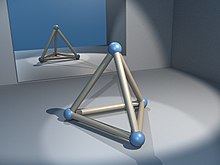Equilateral triangle
| Equilateral triangle | |
|---|---|
 An equilateral triangle is a regular polygon. | |
| Edges and vertices | 3 |
| Schläfli symbols | {3} |
| Coxeter–Dynkin diagrams | |
| Symmetry group | Dihedral (D3) |
| Internal angle (degrees) |
60° |
In geometry, an equilateral triangle is a triangle in which all three sides are equal. In traditional or Euclidean geometry, equilateral triangles are also equiangular; that is, all three internal angles are also congruent to each other and are each 60°. They are regular polygons, and can therefore also be referred to as regular triangles.
Properties
Assuming the lengths of the sides of the equilateral triangle are , we can determine that:
- The area is
- The perimeter is
- The radius of the circumscribed circle is
- The radius of the inscribed circle is
- And the altitude is .
These formulas can be derived using the Pythagorean theorem.
An equilateral triangle is the most symmetrical triangle, having 3 lines of reflection and rotational symmetry of order 3 about its center. Its symmetry group is the dihedral group of order 6 D3.

Equilateral triangles are found in many other geometric constructs. The intersection of circles whose centers are a radius width apart is a pair of equilateral arches, each of which can be inscribed with an equilateral triangle. They form faces of regular and uniform polyhedra. Three of the five Platonic solids are composed of equilateral triangles. In particular, the regular tetrahedron has four equilateral triangles for faces and can be considered the three dimensional analogue of the shape. The plane can be tiled using equilateral triangles giving the triangular tiling.
A result finding an equilateral triangle associated to any triangle is Morley's trisector theorem.
Geometric construction

An equilateral triangle is easily constructed using a compass. Draw a straight line, and place the point of the compass on one end of the line, and swing an arc from that point past halfway of the line segment. Repeat with the other side of the line. Finally, connect the point where the two arcs intersect with each end of the line segment
Alternate method:
Draw a circle with radius r, place the point of the compass on the circle and draw another circle with the same radius. The two circles will intersect in two points. An equilateral triangle can be constructed by taking the two centers of the circles and either of the points of intersection.
Almost-equilateral Heronian triangles
A Heronian triangle is a triangle with rational sides, area and inradius. Since the area of an equilateral triangle with rational sides is an irrational number, no equilateral triangle is Heronian. However, there is a unique sequence of Heronian triangles that are "almost equilateral" because the three sides, expressed as integers, are of the form n − 1, n, n + 1. The first few examples of these almost-equilateral triangles are set forth in the following table.
| Side length | Area | Inradius | ||
|---|---|---|---|---|
| n − 1 | n | n + 1 | ||
| 3 | 4 | 5 | 6 | 1 |
| 13 | 14 | 15 | 84 | 4 |
| 51 | 52 | 53 | 1170 | 15 |
| 193 | 194 | 195 | 16296 | 56 |
| 723 | 724 | 725 | 226974 | 209 |
Subsequent values of n can be found by multiplying the last known value by 4, then subtracting the next to the last one (52 = 4 × 14 − 4, 194 = 4 × 52 − 14, etc), as expressed in
This sequence (sequence A003500 in the OEIS) can also be generated from the solutions to the Pell equation x² − 3y² = 1, which can in turn be derived from the regular continued fraction expansion for √3. [1]
In culture and society
Equilateral triangles have frequently appeared in man made constructions:
- Some archaeological sites have equilateral triangles as part of their construction, for example Lepenski Vir in Serbia.
- The shape also occurs in modern architecture such as Randhurst Mall and the Jefferson National Expansion Memorial.
- The Seal of the President of the Philippines and Flag of Junqueirópolis contain equilateral triangles.
- The shape has been given mystical significance, as a representation of the trinity in The Two Babylons and forming part of the tetractys figure used by the Pythagoreans.
- Tau Kappa Epsilon a NIC Fraternity uses the Equilateral triangle as its primary symbol.
See also
References
- ^ Takeaki Murasaki (2004), On the Heronian Triple (n+1, n, n−1), Sci. Rep. Fac. Educ., Gunma Univ. 52, 9-15.







